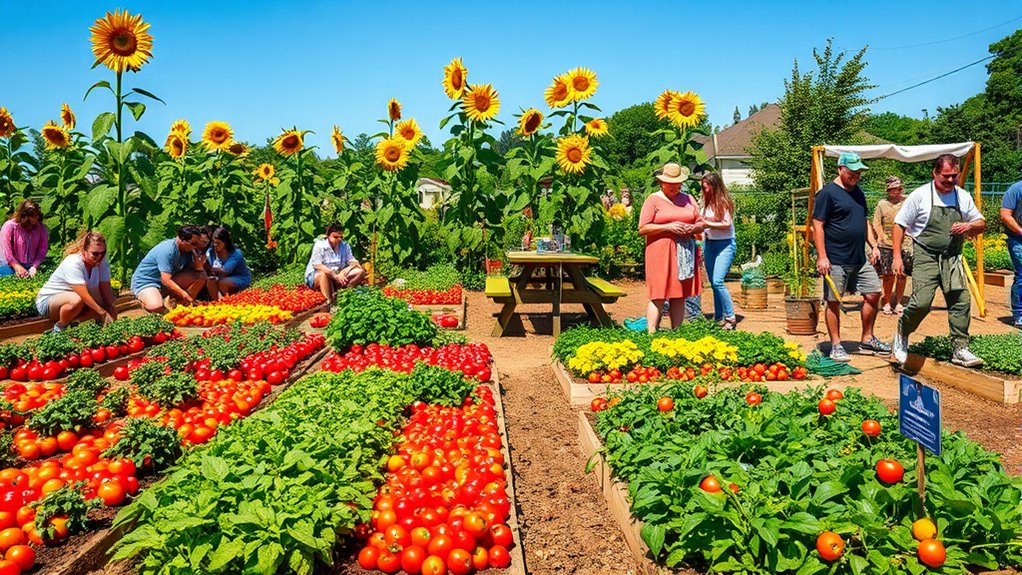Community gardening is a great way to grow fresh food while building connections with neighbors. By transforming vacant lots into shared spaces, you promote sustainability and environmental health. Working together fosters friendships, trust, and a strong sense of belonging. Not only will you enjoy the health benefits of home-grown produce, but you’ll also develop new skills and community pride. If you want to discover how these gardens create vibrant, eco-friendly neighborhoods, keep exploring this inspiring approach.
Key Takeaways
- Community gardens turn vacant lots into green spaces, providing fresh food and fostering neighborhood beautification.
- They promote social interaction, collaboration, and friendship-building among local residents.
- Gardens support sustainable practices like composting, organic farming, and water conservation.
- Educational programs teach children and adults about food origins, environmental respect, and eco-friendly methods.
- Long-term benefits include stronger community bonds, improved quality of life, and environmental sustainability.

Have you ever considered how community gardening can transform your neighborhood? It’s more than just planting vegetables; it’s about building a connected, resilient community while embracing urban farming and sustainable practices. When you get involved in a community garden, you’re participating in a form of urban farming that turns vacant lots or unused spaces into productive, lush green areas. This approach not only provides fresh, healthy food but also promotes sustainable practices that help protect the environment. You’ll learn how to compost, save water, and choose eco-friendly methods that minimize your ecological footprint.
By engaging in community gardening, you’re making your neighborhood greener and more sustainable. Urban farming allows you to grow local food, reducing reliance on store-bought produce that’s often transported long distances, which cuts down on carbon emissions. It’s a practical way to support sustainability right in your backyard. As you tend to your plants, you’ll see firsthand how sustainable practices—like crop rotation, natural pest control, and organic fertilizers—can improve soil health and boost productivity without harming the environment. These methods not only benefit your garden but also set an example for others in the community to follow.
Engaging in community gardening promotes local food, reduces carbon emissions, and models sustainable practices for your neighborhood.
Getting involved in a community garden means sharing resources, knowledge, and labor with neighbors who share your goals. Instead of individual efforts, you’ll work collectively to maximize space and yield, turning an empty lot into a flourishing haven of food and friendship. This collaborative spirit helps foster a sense of belonging, trust, and mutual support. You’ll find that working side by side with others creates friendships that extend beyond gardening, strengthening the social fabric of your neighborhood.
Moreover, community gardening offers educational opportunities for all ages. You can teach kids about sustainable farming practices, show them where food comes from, and instill in them a respect for the environment. For adults, it’s a chance to learn new skills, from composting to organic pest management, that can be applied elsewhere in daily life. The shared experience of nurturing plants and witnessing growth builds a sense of pride and accomplishment that’s hard to match. Additionally, understanding building codes and permits can help ensure your project complies with local regulations and runs smoothly.
In the end, community gardening isn’t just about growing food; it’s about cultivating community, sustainability, and a better quality of life. By participating, you’re helping transform your neighborhood into a more vibrant, eco-friendly place to live. It’s an activity that offers tangible benefits—fresh produce, new friendships, and a healthier environment—while also nurturing a sense of purpose and connection that lasts long after the last harvest.
Frequently Asked Questions
How Do I Start a Community Garden in My Neighborhood?
To start a community garden, first gather neighbors interested in growing food. Choose a suitable site and plan your garden layout. Focus on seed selection to guarantee plants thrive in your climate, and teach composting techniques to enrich your soil naturally. Obtain necessary permits, organize volunteer schedules, and promote the project locally. With dedication and teamwork, you’ll create a thriving space where everyone can enjoy fresh produce and build friendships.
What Are Common Challenges Faced by Community Gardeners?
You’ll often face challenges like soil preparation and pest management. Poor soil can hinder plant growth, so you need to improve it with compost or amendments. Pests can damage crops, so you should implement natural pest control methods or barriers. Staying vigilant and proactive helps you overcome these issues, ensuring a healthy, productive garden where community members can enjoy growing food and building friendships.
How Can I Attract Diverse Participants to Join?
Think of your garden as a vibrant mosaic, each piece representing different cultures. To attract diverse participants, promote cultural inclusivity by hosting multilingual events and using inclusive language in flyers. Reach out through community centers and social media in various languages. Show respect for different traditions, making everyone feel valued. When you create a welcoming space, you’ll draw in a rich tapestry of gardeners, strengthening your community’s bonds and diversity.
What Funding Options Are Available for Community Gardening Projects?
You can find funding through grant opportunities from local government, nonprofits, and environmental organizations, which often support community gardening projects. Additionally, explore sponsorship programs where local businesses or community members provide financial support or resources. Applying for these grants and sponsorships requires a clear project plan and community impact focus. Securing funding helps cover supplies, tools, and educational programs, making your community garden more accessible and sustainable.
How Do Community Gardens Impact Local Ecosystems?
You’ll see that community gardens positively impact local ecosystems by supporting native plantings, which attract pollinators like bees and butterflies. These gardens create essential wildlife habitats, offering shelter and food sources for birds and insects. By incorporating native plants, you help sustain biodiversity, improve soil health, and promote a balanced environment. Your efforts foster a thriving ecosystem, enriching both the community and the natural surroundings.
Conclusion
By joining your local community garden, you’ll cultivate more than just crops—you’ll create connections, community, and a sense of belonging. As you plant, water, and harvest together, you’ll discover the true power of partnership and patience. Remember, community gardening isn’t just about growing food; it’s about growing friendships, fostering fun, and fueling your faith in the future. So, step in, sow seeds, and watch your community flourish with friendship and flavor.








